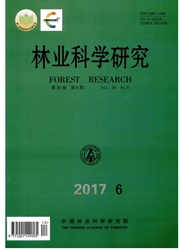

 中文摘要:
中文摘要:
以贵州喀斯特地区3种针叶林为研究对象,采用标准样地调查和生物量实测数据,对各生态系统的生物量、碳含量以及碳储量进行研究分析。结果表明:马尾松天然林、马尾松人工林和湿地松人工林生态系统乔木生物量分别为103.46、140.55、164.15 t/hm^2;林下植被及死地被物层生物量分别为7.762、6.994、8.622 t/hm^2。林木各器官含碳量:马尾松天然林0.427-0.530 gC/g、马尾松人工林0.443-0.574 gC/g、湿地松人工林0.444-0.466gC/g。3种森林生态系统碳储量分别为:马尾松天然林678.025 t/hm^2、马尾松人工林777.11 t/hm^2、湿地松人工林834.135 t/hm^2。其中植被层分别为48.199、70.788、76.438 t/hm^2;死地被物层为0.667、0.659、0.742 t/hm^2;土壤层为629.159、705.664、756.955 t/hm^2。碳储量分布格局为土壤层〉植被层〉死地被物层。研究结果可以为贵州喀斯特地区针叶林管理及运营提供基础数据。
 英文摘要:
英文摘要:
Afforestation and restoration are vital contributors for offsetting greenhouse gas emissions. However, when compared to native species, how fast-growing exotic tree speeies will influence the local ecosystem process remains poorly understood. In this study, the carbon storage and biomass in vegetation and soil were compared one of three ways, natural native masson pine (Pinus massoniana), planted native masson pine, or exotic slash pine(Pinus elliottii)plantation.The results showed that biomass of overstory vegetation was 103.46、 140.55、164.15 t/hm: in natural masson pine forest, masson pine plantation, and slash plantation, respectively. The mean carbon storage was 678.025 t/hm^2 in natural masson pine forest, 777.11 t/hm^2 in masson pine plantation, and 834.135 t/hm^2 in slash pine plantation. Carbon content ranges from 0.427-0.530 gC/g in natural masson pine forest, 0.443-0.574 gC/g in masson pine plantation, and 0.444-0.466 gC/g in slash pine plantation. For understory vegetation, 0.659-0.742 gC/g in litter layer, and 629.159-756.955 gC/g in the soil. The carbon (C) content of soil of the three forest types decreased with soil depth. The distribution of C storage was soil 〉 vegetation 〉 litter. The results provide a scientific basis and reference for coniferous forest management and long-term location monitoring.
 同期刊论文项目
同期刊论文项目
 同项目期刊论文
同项目期刊论文
 期刊信息
期刊信息
